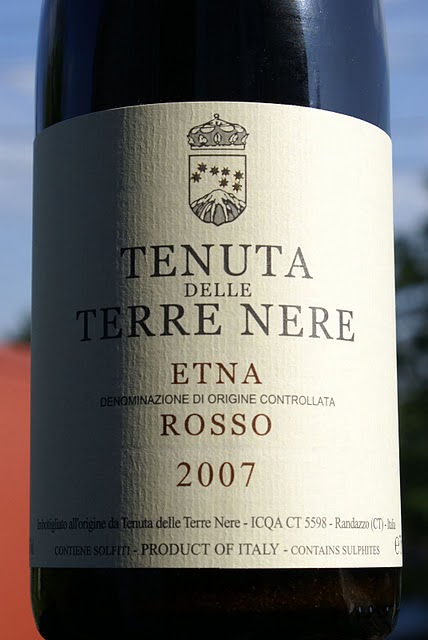In Sicily: Etna trek
Sicily vineyard tour day 1: Etna trek, clashing with lava, and enjoying a good Grenache.
Sicily vineyard tour day 1: Etna trek, clashing with lava, and enjoying a good Grenache.
Sicily’s rising star Arianna Occhipinti makes controversial wines. After lukewarm impressions from the 2007 vintage I have a look at the 2009 Il Frappato and man, this wine rocks!
Sicily’s Cerasuolo di Vittoria is an unexpected wine: light, airy, perfumed and Burgundian though it comes from Europe’s southernmost corner.
Forget flabby, low-acid, jammy, oxidative wine from Sicily. Here’s something really fresh and elegant. Plus a nice 19th-century drawing.
So how’s the Murgo Etna Rosso 2007? It’s a very typical Etna red in colour – which is fairly light –, aroma and flavour. Fresh and zesty with bitter cherry fruit, dried Mediterranean herbs and that unmistakeable sweet Oriental spice signature of Nerello. It’s a red with a real sense of minerality, unoaked, transparent, cool and stoney. With firm tannins and high acidity on the finish, it’s a little challenging at this stage without food, but is well-balanced with a sense of drinkability. Fairly low alcohol. A fairly simple wine, and for a while I regretted the good people from Murgo make no more ‘ambitious’ bottling, but after all it’s a welcome choice: inexpensive, supremely drinkable and with a sense of place, it’s unfair to ask more of this wine.
Speaking of ‘ambition’, it’s surely what characterises my second wine: Passopisciaro 2006. Founded by the notorious Andrea Franchetti whose Tuscan wines from the Tenuta di Trinoro have gathered massive critical attention, it’s a sky-is-the-limit interpretation of Etna red wine. 80- to 100-year-old bush vines on remote terraces on Etna’s northern, mountain-cool, arid slope, minimal yields and state-of-the-art vinification yield a wine of stunning intensity and personality.
The colour is almost shockingly light and the nose is meaty, spicy, only faintly fruit with plenty of mineral depth. The first sip on palate is just outstanding. Quite round and ripe (it’s 14.5% alc. in this warm vintage, but well-balanced), it is typical of red Etna in being moderate in acidity but beguilingly refreshing and very digest. Balsamic texture and impressive length add to the picture. In that silkiness and puréed fruit richness, this vaguely resembles a Grenache-based wine from the Rhône or Languedoc, and is similarly elegant to a traditional-style Châteauneuf, but has more poise and those crystalline tannins of the Etna.
This wine costs 30€ (it can be picked up e.g. at the Catania airport). While a bit expensive by Sicilian standards, it is definitely worth it; a Burgundy or Châteauneuf of similar stature would set you twice that. Delicious and supremely drinkable, but layered with a real sense of dimension, this is just great wine.
Disclaimer
Source of wines: own purchases.

As per my habit of gauging my palate to the forthcoming bunch of wines I opened the Tenuta delle Terre Nere Etna Rosso 2007. Terre Nere is the Etna venture of
Marc De Grazia, an influential importer of Italian wines into the US that has been one of the architects of Italian wine’s success on the American market. Interestingly, while much of De Grazia’s original catalogue represented some of the most modern trends in Italian wine (including some new French oak-aged Barolos and Barbarescos), the wines of Terre Nere show quite some respect for tradition. It’s evident by the light bricky colour of this red and also its bouquet: showing lots of finesse and a subdued minerality, it isn’t overly fruity or upfront. The red wines of Etna are often compared to burgundies (and the local grape, Nerello, is yet another ‘Pinot Noir of the Mediterranean’), and while it’s often an abused comparison, here it’s really right. The ripe, fleshy, gently spicy, hauntingly flowery aroma of this 2007 could well be that of a warm-vintage Volnay or Chambolle.The flavour of this wine is really interesting. The balance is quite unique. Acidity is not very high but there is a mineral coolness and restraint at the core; the fruity notes echo the nose with fleshy cherries and ripe currants, and there is a perfumed flowery undertone. Surprisingly for a wine with such light body and flowery finesse, the tannins on the finish are quite sturdy. Finesse, minerality and tannins: these elements do not often go together in a red wine. This 2007, Terre Nere’s basic cuvée (they also make several single-vineyard bottlings), is really overdelivering for the price, developing very well in the glass. It’s boding well for my Etna excursion – read more about it soon on this blog.
Long underdeveloped, Sicilian wines are gathering momentum. But few of the whites are exciting. Here’s the best of them all, made from the local Grillo grape.